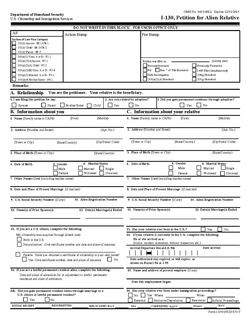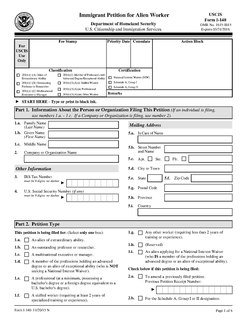Related Research Articles

A green card, known officially as a permanent resident card, is an identity document which shows that a person has permanent residency in the United States. Green card holders are formally known as lawful permanent residents (LPRs). As of 2019, there are an estimated 13.9 million green card holders of whom 9.1 million are eligible to become United States citizens. Approximately 65,000 of them serve in the U.S. Armed Forces.

The Immigration Act of 1990 was signed into law by George H. W. Bush on November 29, 1990. It was first introduced by Senator Ted Kennedy in 1989. It was a national reform of the Immigration and Nationality Act of 1965. It increased total, overall immigration to allow 700,000 immigrants to come to the U.S. per year for the fiscal years 1992–94, and 675,000 per year after that. It provided family-based immigration visa, created five distinct employment based visas, categorized by occupation, and a diversity visa program that created a lottery to admit immigrants from "low admittance" countries or countries whose citizenry was underrepresented in the U.S.
An L-1 visa is a visa document used to enter the United States for the purpose of work in L-1 status. It is a non-immigrant visa, and is valid for a relatively short amount of time, from three months to five years, based on a reciprocity schedule. With extensions, the maximum stay is seven years.
An Application for Waiver of Grounds of Inadmissibility is an application for legal entry to the United States made by an individual who is otherwise inadmissible on one or more grounds. The application is submitted to the consular office, U.S. Citizenship and Immigration Services office or immigration court considering the immigrant visa or adjustment of status application.
A K-1 visa is a visa issued to the fiancé or fiancée of a United States citizen to enter the United States. A K-1 visa requires a foreigner to marry his or her U.S. citizen petitioner within 90 days of entry, or depart the United States. Once the couple marries, the foreign citizen can adjust status to become a lawful permanent resident of the United States. Although a K-1 visa is legally classified as a non-immigrant visa, it usually leads to important immigration benefits and is therefore often processed by the Immigrant Visa section of United States embassies and consulates worldwide.

Parole, in the immigration laws of the United States, generally refers to official permission to enter and remain temporarily in the United States, under the supervision of the U.S. Department of Homeland Security (DHS), without formal admission, and while remaining an applicant for admission.
The USA PATRIOT Act was passed by the United States Congress in 2001 as a response to the September 11, 2001 attacks. It has ten titles, each containing numerous sections. Title IV: Protecting the Border aims to prevent terrorism in the USA through immigration regulations. The provisions of the title generally increase the difficulty of entering the country for those known to have, or suspected of having, terrorist intent.
U.S. Citizenship and Immigration Services (USCIS) is an agency of the United States Department of Homeland Security (DHS) that administers the country's naturalization and immigration system. It is a successor to the Immigration and Naturalization Service (INS), which was dissolved by the Homeland Security Act of 2002 and replaced by three components within the DHS: USCIS, Immigration and Customs Enforcement (ICE), and Customs and Border Protection (CBP).
The V visa is a temporary visa available to spouses and minor children of U.S. lawful permanent residents. It allows permanent residents to achieve family unity with their spouses and children while the immigration process takes its course. It was created by the Legal Immigration Family Equity Act of 2000. The Act is to relieve those who applied for immigrant visas on or before December 21, 2000. Practically, the V visa is currently not available to spouses and minor children of LPRs who have applied after December 21, 2000.

The visa policy of the United States consists of the requirements for foreign nationals to travel to, enter, and remain in the United States. Visitors to the United States must obtain a visa from one of the U.S. diplomatic missions unless they come from one of the visa-exempt or Visa Waiver Program countries. The same rules apply for travel to all U.S. states, the District of Columbia, Puerto Rico and the U.S. Virgin Islands, as well as to Guam and the Northern Mariana Islands with additional waivers, while similar but separate rules apply to American Samoa.
The Comprehensive Immigration Reform Act was a United States Senate bill introduced in the 109th Congress (2005–2006) by Sen. Arlen Specter [PA] on April 7, 2006. Co-sponsors, who signed on the same day, were Sen. Chuck Hagel [NE], Sen. Mel Martínez [FL], Sen. John McCain [AZ], Sen. Ted Kennedy [MA], Sen. Lindsey Graham [SC], and Sen. Sam Brownback [KS].

A Form I-766 employment authorization document or EAD card, known popularly as a work permit, is a document issued by the United States Citizenship and Immigration Services (USCIS) that provides temporary employment authorization to noncitizens in the United States.
Title 8 of the United States Code codifies statutes relating to aliens and nationality in the United States Code.
The Security Through Regularized Immigration and a Vibrant Economy Act of 2007 or STRIVE Act of 2007 is proposed United States legislation designed to address the problem of illegal immigration, introduced into the United States House of Representatives. Its supporters claim it would toughen border security, increase enforcement of and criminal penalties for illegal immigration, and establish an employment verification system to identify illegal aliens working in the United States. It would also establish new programs for both illegal aliens and new immigrant workers to achieve legal citizenship. Critics allege that the bill would turn law enforcement agencies into social welfare agencies as it would not allow CBP to detain illegal immigrants that are eligible for Z-visas and would grant amnesty to millions of illegal aliens with very few restrictions.

Bhutanese nationality law is the law governing the acquisition, transmission and loss of Bhutanese citizenship. The Bhutanese Citizenship Act of 1985 was introduced by the Druk Gyalpo Jigme Singye Wangchuck, on June 10, 1985, modifying the definition of a Bhutanese citizen. The Act was implemented as part of a new national policy of Driglam Namzha, national customs and etiquette. Because of its emphasis on Bhutanese culture, the Act is also referred to as the "One Nation, One People Act." The 1985 Act was amended by the Immigration Act of 2007 and then superseded in 2008 by the Constitution of Bhutan insofar as previous laws are inconsistent; where not inconsistent, the provisions of the 2007 Act, the 1985 Act, and previous Acts relating to immigration continue in effect.
The U visa is a United States nonimmigrant visa which is set aside for victims of crimes who have suffered substantial mental or physical abuse while in the U.S. and who are willing to assist law enforcement and government officials in the investigation or prosecution of the criminal activity. It permits such victims to enter or remain in the US when they might not otherwise be able to do so.

Form I-130, Petition for Alien Relative is a form submitted to the United States Citizenship and Immigration Services by a United States citizen or Lawful Permanent Resident petitioning for an immediate or close relative intending to immigrate to the United States. It is one of numerous USCIS immigration forms. As with all USCIS petitions, the person who submits the petition is called the petitioner and the relative on whose behalf the petition is made is called the beneficiary. The USCIS officer who evaluates the petition is called the adjudicator.
The Legal Immigration Family Equity Act of 2000, also known as the LIFE Act and as the Legal Immigration and Family Equity Act, along with its Amendments, made some changes to laws surrounding immigration for family members of United States citizens and Lawful Permanent Residents, as well as people eligible for employment-based immigrant visas, in the direction of making it easier for family members and immigrant workers to move to and adjust status within the United States. It was passed on December 21, 2000, as title XI of Pub.L. 106–553 (text)(PDF).
Special Immigrant Juvenile Status (SIJS) is a special way for minors currently in the United States to adjust status to that of Lawful Permanent Resident despite unauthorized entry or unlawful presence in the United States, that might usually make them inadmissible to the United States and create bars to Adjustment of Status. The key criterion for SIJS is abuse, neglect, or abandonment by one or both parents.

Form I-140, Immigrant Petition for Alien Worker is a form submitted to the United States Citizenship and Immigration Service (USCIS) by a prospective employer to petition an alien to work in the US on a permanent basis. This is done in the case when the worker is deemed extraordinary in some sense or when qualified workers do not exist in the US. The employer who files is called the petitioner, and the alien employee is called the beneficiary; these two can coincide in the case of a self-petitioner. The form is 6 pages long with a separate 10-page instructions document as of 2016. It is one of the USCIS immigration forms.
References
- ↑ "Public Law 102-110 102d Congress" (PDF). 1991.[ permanent dead link ]
- 1 2 http://thomas.loc.gov/cgi-bin/bdquery/z?d102:SN00296%5B%5D:
- ↑ "Armed Forces Immigration Adjustment Act of 1991 (1991 - S. 296)".
- 1 2 3 4 5 9 FAM 502.5-8(B)
- ↑ Overmyer-Vala, Mark. "Transforming Race and Nation." Latin American Perspectives. SAGE, 7 November 2008. Web.
- 1 2 Schmidt, Paul. "Business-related Provisions of the Immigration Act of 1990."In Defense of the Alien Vol. 15. 1992. JSTOR. Web.
- 1 2 Delmando, Rogie. "Armed Forced Immigration Adjustment Act" Histories for Filipino U.S. Navy Military.com. 6 September 2002. Web.